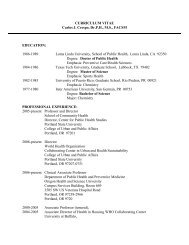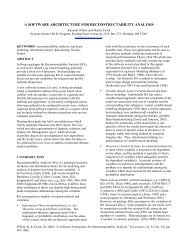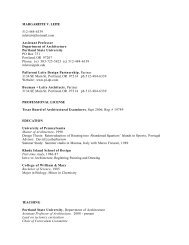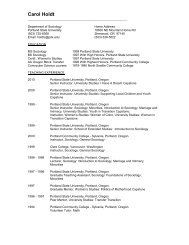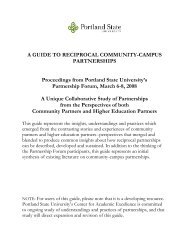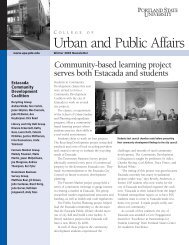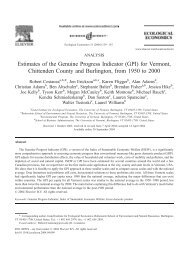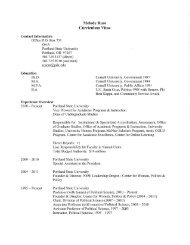Effects of integral stimulation therapy on speech - Portland State ...
Effects of integral stimulation therapy on speech - Portland State ...
Effects of integral stimulation therapy on speech - Portland State ...
You also want an ePaper? Increase the reach of your titles
YUMPU automatically turns print PDFs into web optimized ePapers that Google loves.
Table 1.<br />
Rosenbek et al.’s Hierarchical Eight-Step C<strong>on</strong>tinuum Treatment Program for AOS (1973)<br />
1. The client is instructed to watch and listen to the clinician. The clinician and client<br />
produce the target utterance simultaneously. Meanwhile, the clinician encourages the<br />
client to attend carefully to the auditory and visual cues <str<strong>on</strong>g>of</str<strong>on</strong>g> the correct producti<strong>on</strong>.<br />
2. The client repeats the target utterance, after the clinician models the producti<strong>on</strong>, while<br />
the clinician mouths the utterance (simultaneous auditory cues faded while visual<br />
supports remain).<br />
3. The clinician produces the target utterance and the client repeats it. No other visual or<br />
auditory clues are given during client’s producti<strong>on</strong>.<br />
4. The clinician produces the target utterance and client repeats it several times<br />
(correctly) with no intervening cues.<br />
5. The client reads/names the target utterance written/pictured <strong>on</strong> a card.<br />
6. Similar to step 5, but the client resp<strong>on</strong>ds after the target card (stimulus) has been<br />
removed.<br />
7. Client uses the target utterance sp<strong>on</strong>taneously when asked an appropriate questi<strong>on</strong> by<br />
the clinician. The imitative model is no l<strong>on</strong>ger in use. This allows the client to produce<br />
the target utterance voliti<strong>on</strong>ally.<br />
8. The target utterance is incorporated into role-playing situati<strong>on</strong>s. The clinician, staff,<br />
parents, and friends assume roles appropriate to the target utterance and the client<br />
resp<strong>on</strong>ds appropriately. (With children target utterances can be practiced in the c<strong>on</strong>text<br />
<str<strong>on</strong>g>of</str<strong>on</strong>g> games and theme-based role-plays.<br />
________________________________________________________________________<br />
Following the successful treatment <str<strong>on</strong>g>of</str<strong>on</strong>g> adults with acquired apraxia <str<strong>on</strong>g>of</str<strong>on</strong>g> <strong>speech</strong>, the<br />
method has been applied to children diagnosed with n<strong>on</strong>-acquired apraxia <str<strong>on</strong>g>of</str<strong>on</strong>g> <strong>speech</strong><br />
(CAS), and is producing positive treatment results as well (Edeal, 2008; Jakielski, et al.,<br />
2006; Jensen, 2005; Strand & Debertine, 2000). Integral <str<strong>on</strong>g>stimulati<strong>on</strong></str<strong>on</strong>g> employs multiple<br />
modalities <str<strong>on</strong>g>of</str<strong>on</strong>g> cueing systems for the <str<strong>on</strong>g>stimulati<strong>on</strong></str<strong>on</strong>g> <str<strong>on</strong>g>of</str<strong>on</strong>g> <strong>speech</strong>. Clinicians using this approach<br />
draw from a wide range <str<strong>on</strong>g>of</str<strong>on</strong>g> visual, auditory, and tactile cues to model for the child. The<br />
child is instructed to “watch me and listen to me.” The <strong>speech</strong> movement is then<br />
explicitly modeled for the child who then attempts the producti<strong>on</strong>. Depending <strong>on</strong> the<br />
level <str<strong>on</strong>g>of</str<strong>on</strong>g> need, a child is provided with a hierarchy <str<strong>on</strong>g>of</str<strong>on</strong>g> supportive cues. Maximal support<br />
starts with tactile cues and visual and auditory models, with both child and clinician<br />
16



